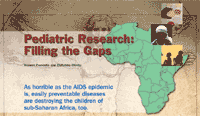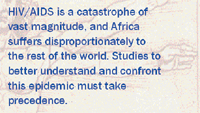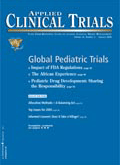Pediatric Research: Filling the Gaps
The data obtained by The Bellagio Child Survival Study Group has made the identification of priority research subjects more precise and relevant to developing countries.
The data obtained by The Bellagio Child Survival Study Group1-6 has made the identification of priority research subjects more precise and relevant to developing countries. About 10.8 million children under 5 years of age die each year, mostly from preventable diseases (about 6 million), and almost all in poor countries. Sub-Saharan Africa accounts for 41% of these deaths; of the 42 countries worldwide with the highest mortality rates, 36 are African. The causes of these deaths are the familiar diseases of childhood: 25% of these sub-Saharan deaths are due to neonatal causes, 22% to malaria, 21% to pneumonia, 20% to diarrhea, and 8% to AIDS. Measles accounts for 1% of global death for those under 5 years of age.
Roughly 6.8 million of these deaths could be prevented or treated by well-established and simple interventions against the main causes. However, global coverage of these interventions is under 50%. The key interventions are listed by Gareth Jones et al.,3 and include breastfeeding, insecticide-treated materials, oral rehydration therapy, antibiotics for pneumonia, antimalarials, complementary feeding, water, sanitation, and hygiene. Several interventions need to be supported by better levels of evidence, which include rotavirus, pneumococcal vaccines, reduction of indoor air pollution, zinc for pneumonia, and intermittent antimalarial preventive treatment in infants.3

Pediatric Research: Filling the Gaps
Infant and child deaths in developing countries are often due to several risk factors and diseases, often acting synergistically (e.g., infectious diseases and malnutrition). The combined effects of these co-morbidities and multiple risk factors should be estimated collectively and independently. Accordingly, a major focus for research is to determine the most effective and cost-efficient approaches to providing these interventions at population level. Studies are required to determine the quickest route from knowledge to effective action, and must recognize that leadership, strong health systems, efficient use of resources, and poverty alleviation measures are critical elements.6
At a recent workshop on Global Paediatric Research,7 Demisse Habte from the World Bank made a strong case for important infrastructural requirements. Habte stressed partnerships, fostering communication among researchers, tackling the "brain drain," building research capacity, training, advocacy, and ethical studies. Noting that only 3% of Cochrane Collaboration research were "effectiveness" studies, the issue of "the science of scaling up" of existing knowledge in the context of program implementation was repeatedly emphasized at this meeting. The gaps in knowledge of problems such as iron-deficiency, anemias, neonatal disorders, newer vaccines, and effect of birth spacing and obstetric care on infant and child survival also need attention through careful research.

There remain many gaps in the evidence for effective action to improve child survival. These have been recently summarized6 and are therefore not repeated here. Scrupulous examination of health delivery systems is an essential field for study.4 Sound data are required on epidemiology, services and community preferences, selection of appropriate interventions, scale of coverage with either selected or multiple interventions, matching supply with demand, and strengthening of health services.
The Bellagio Group makes a strong case for directing resources and interventions for child survival to poor populations in all countries. In particular, it would address the inequities within countries as well as between countries. Victora et al.5 suggest the following as potential approaches for reducing inequities: improving knowledge and changing behavior; increasing access to water and sanitation; empowering women; rendering health care affordable, accessible, and user-friendly; enhancing human and other resources in facilities serving the poor, and providing adequate budget allocations. It is necessary to gather better evidence for the impact of all these approaches.

Improving child health: Review of research
In a recent literature review of research for improving child health in developing countries, a set of key findings similar to those noted above were documented. These included research gaps in prevention of respiratory diseases and neonatal mortality (there are 4 million neonatal deaths worldwide every year), accessibility to vaccines, insufficient financial investments, inadequate selection of research priorities, and building of research capacity.
HIV/AIDS is a catastrophe of vast magnitude, and Africa suffers disproportionately to the rest of the world. Studies to better understand, confront, and drive back this epidemic, and to prevent new infections and treat and care for those already infected, must unquestionably take precedence. However, we have just said that there is a huge agenda of unfinished responsibilities we owe to the majority of the world's children who do not receive the benefits of known or proven preventive and therapeutic measures. It follows that in the countries affected by the HIV epidemic, a balance must be established between research into the pressing demands of the majority—children sick and dying from easily treatable diseases—and the desperate needs of children at risk of or infected by HIV. Research funds in many countries in Africa are being diverted away from the former, given the prominence of HIV/AIDS, the fears and myths enfolding the disease, community awareness, and the escalating global response to it. Indeed, Gareth Jones and colleagues bemoan the "levels of attention and effort directed at preventing the small proportion of child deaths due to AIDS with a new, complex, and expensive intervention (that seem) to be outstripping the efforts to save millions of children every year with a few cents worth of (interventions). This must change."3 While this cautionary note could be questioned in the heavily HIV-affected region of southern Africa, in global terms we believe it is probably relevant.
HIV/AIDS
By 2002 there were 3.2 million children (<15 years of age) living with HIV in the world; 800,000 children had become newly infected in that year and about 610,000 had died. This amounts to 1,671 child deaths per day, 70 deaths per hour and 1.2 deaths per minute! By the end of 2003, the figures for adults and children living with HIV/AIDS in sub-Saharan Africa were between 25.0 and 28.2 million, out of a global total of 34 to 46 million. In sub-Saharan Africa 3.0 to 3.4 million became newly infected with HIV (global total was between 4.2 and 5.8 million). There were 2.2 to 2.4 million deaths due to AIDS (global total was between 2.5 and 3.5 million).
Infants are mostly infected from their mothers, so antenatal prevalence figures are an important source of the extent of risk. These prevalences vary according to country and within countries. In southern Africa antenatal prevalences can be as high as 40% and over, in East Africa they are between 20% and 30%, and are lower in some West African countries. These figures are said to be higher than population-wide estimates. Accurate national figures of HIV incidence and prevalence are essential for developing policies and providing services. Such databases have to be strengthened or established in developing countries as they are a prerequisite for epidemiological and population-based studies. Although vertical transmission is generally accepted to account for about 95% of infant and child HIV infections, there have been dissenting voices. More research is required into the minority of infections (about 5%) from alternative sources of transmission such as sexual abuse, contaminated needles, blood products and tissue transplants, and injuries in health care settings.
A recent South African study9 found that 6.7% of children 2-9 years of age were HIV infected, while 4.7% of 10-to-14-year-olds were HIV infected. There is considerable scope for work determining the natural history and extent of HIV infection among children in different age groups in Africa.
The intrauterine, intrapartum, and postnatal periods are when mother-to-child-transmission (MTCT) of HIV occurs. In developing countries MTCT at 24 months of infant age has been reduced from about 30%-45% to 16%-23% with the use of ARVs (antiretrovirals); the main effect has been on intrapartum transmission. It is widely recognized that in Africa, the percentage of HIV-positive women attending antenatal clinic (ANC) services who actually receive ARVs remains low. Attrition from the total numbers who attend ANCs occur in a cascade from those refusing HIV counseling, accepting HIV testing, returning for the HIV results, receiving the ARVs, and adhering to the regimen. Measures to improve this situation vary according to site and have to be addressed locally.
There is a new cadre of healthcare workers who have to be trained: counselors. The number required per site, the training necessary, salaries, and regular support are all important and should form part of operational research. It is unclear whether a generalist counselor (who deals with counseling for HIV testing, infant feeding, ARV advice, and support) is preferable to a "specialist" single-issue counselor (one each for the three types of counseling). WHO has an excellent scheme for a comprehensive approach to pMTCT, preventing the transmission. This framework includes four levels of interventions:
1) Prevention of HIV in women
2) Prevention of unintended pregnancies in HIV-infected women
3) Preventing MTCT
4) Care and support for HIV-infected women, their infants, partners, and families.
It will be very important to subject this broad-based approach to critical evaluation. For example, the social dimensions of the medium and long-term effects on family integrity, child growth and development, and the delay in orphanhood are putative benefits of extending care, especially ARVs, to the family. They can have major positive consequences.
While some risk factors and the rates of transmission for the first two routes are documented, we have only an approximate understanding of the rates and determinants of breastfeeding transmission. Definitions of timing of transmission vary. Breastfeeding accounted for at least 24% and as much as 42% of overall transmission (intrauterine, intrapartum, and postnatal). The risk of transmission is constant throughout breastfeeding, and the risk is related to lower maternal CD4 count and male sex. The authors conclude that interventions to decrease breastfeeding transmission of HIV are urgently needed, and the mechanisms underlying the association between male sex and breastfeeding transmission should be further investigated.
The role of the type of breastfeeding (exclusive versus mixed) on MTCT risks are being investigated in a number of African settings. The short, medium, and long-term impact of formula feeding and the avoidance of breastfeeding in HIV-infected populations on infant growth, development, and overall child mortality has to be monitored and evaluated. It is estimated that breastfeeding prevents about 13%-15% of all under-5 deaths in high and low HIV-prevalence regions, respectively.3 It will therefore be of considerable interest to observe the impact of the policy choices governments make on breast or formula-feeding for HIV-infected women.
There are at least four trials to assess the role of ARVs in reducing breastfeeding transmission: the results of two of these (SIMBA and MITRA) have been presented and show promising reductions of breastfeeding transmission associated with administration of ARVs to breastfeeding babies. However, the trial designs in both studies prevent firm conclusions on efficacy of the use of postnatal ARVs to reduce breastfeeding transmission. The use of HIV vaccines and passive immunization with specific antibodies to HIV in children are innovative approaches to preventing breastfeeding transmission.
Much more work needs to be done to determine the ARVs employed and the implementation of trials to reduce mother-to-child-transmission of HIV-1.
The all-embracing and comprehensive care of HIV-infected children, their mothers, siblings, and fathers is a challenge which now confronts developing countries. For the infant, the optimal management of the common and uncommon manifestations of progressive HIV infection, the concomitant opportunistic infections, and co-infections is still an open field for properly designed trials. For example, the most effective management of community-acquired pneumonias in HIV-affected populations has not been determined.
Researchers will be constrained only by the limits of their imagination and creativity. At a minimum, these programs should be rooted in a milieu which ensures:
- political commitment
- acceptance by local chiefs
- preparation and acceptance by the target communities
- training of health workers
- upgrading of facilities
- strong information and data infrastructure
- guidelines for drug selection and use
- monitoring of adherence and toxicities
- dedicated budgets, procurement, supply and regular distribution of drugs, etc.
Treatment programs should go hand in hand with prevention programs.
There is a remaining lacuna in data on mortality of HIV-infected and HIV-exposed but uninfected children. Although natural history studies will probably be unethical, much can be gained by careful observation of treated children. The causes of differing child mortality rates according to geographical location in Africa, and the contribution of HIV/AIDS to under-5 mortality in HIV affected countries, are critical subjects for study. From some estimates, HIV/AIDS is responsible for up to 44% of child mortality in the high-prevalence regions.11
AIDS orphans, all orphans, and vulnerable children, are often neglected by state health and welfare services, and frequently ignored by scientists. There are about 15.6 million AIDS orphans globally, 12.1 million of whom are in Africa, and possibly 391,000 in South Africa. In a recent national South African study,9 10% of children surveyed had lost a parent by the time they were 9 years old, and 25% had lost a parent by 15-18 years of age. There is much to be done in exploring and implementing the most effective support and rehabilitation measures for such children.
References
1. Editorial, "The World`s Forgotten Children,"
Lancet,
361 (1) (2003).
2. R.E. Black, S.S Morris, J. Bryce, "Where and Why Are 10 Million Children Dying Every Year?" Lancet, 361, 2226-2234 (2003).
3. G. Jones, R.W. Steketee, R.E. Black, et al., "How Many Child Deaths Can We Prevent This Year?" Lancet, 362, 65-71 (2003).
4. J. Bryce, S. el Arifeen, G. Pariyo, et al., "Reducing Child Mortality: Can Public Health Deliver?" Lancet, 362, 159-164 (2003).
5. C.G. Victora, A. Wagstaff, J.A. Schellenberg, et al., "Applying an Equity Lens to Child Health and Mortality: More of the Same Is Not Enough," Lancet, 362, 233-241 (2003).
6. The Bellagio Study Group on Child Survival, "Knowledge into Action for Child Survival," Lancet, 362, 323-327 (2003).
7. A. Zipursky, "The Programme for Global Paediatric Research," workshop minutes (5 May, 2004) San Francisco, CA, USA.
8. J. Orne-Gliemann, F. Perez, V. Leroy et al., "Improving Child Health in Developing Countries: The Critical Role of Research," BMJ, 324, 1444-1447 (2003).
9. N. Mandela, Human Sciences Research Council Study of HIV/AIDS, National Household HIV Prevalence and Risk Survey of South African Children, Human Sciences Research Council (2002).
10. The Breastfeeding and HIV International Transmission Study Group, "Late postnatal Transmission of HIV-1 in Breast-fed Children: An Individual Patient Data Meta-analysis," JID, 189, 2154-2166 (2004).
11. N. Walker, B. Schwartlander, J. Bryce, "Meeting International Goals in Child Survival and HIV/AIDS," Lancet, 360, 285-89 (2002).
Hoosen Coovadia, FCP (Peds), MSc, MD, is the Victor Daitz Professor of HIV/AIDS Research with the Nelson Mandela School of Medicine, University of Kwazulu/Natal, Durban. Chifumbe Chintu,* MD, FRCPC, FRCP (London), is professor of Paediatrics and Child Health with the University Teaching Hospital School of Medicine, University of Zambia, email: cchintu@zamnet.zm.
*To whom all correspondence should be addressed.

Final ENLIVEN Trial Results Confirm Long-Term Benefit of Turalio in Tenosynovial Giant Cell Tumor
July 9th 2025In final data from the Phase III ENLIVEN study, Turalio (pexidartinib) demonstrated durable tumor responses and a consistent safety profile in patients with symptomatic TGCT not amenable to surgery.
Unifying Industry to Better Understand GCP Guidance
May 7th 2025In this episode of the Applied Clinical Trials Podcast, David Nickerson, head of clinical quality management at EMD Serono; and Arlene Lee, director of product management, data quality & risk management solutions at Medidata, discuss the newest ICH E6(R3) GCP guidelines as well as how TransCelerate and ACRO have partnered to help stakeholders better acclimate to these guidelines.
FDA Expands Farapulse PFA Approval to Persistent AF After Strong ADVANTAGE AF Trial Results
July 7th 2025Boston Scientific’s Farapulse Pulsed Field Ablation System is now approved for treating persistent atrial fibrillation, following 12-month data from the ADVANTAGE AF trial showing strong safety, high freedom from AF, and no major complications.
Effect of AI/ML, Real World Evidence and Master Protocols on Trial Success
July 7th 2025How the application of artificial intelligence, broader use of real-world evidence, decentralized clinical trials, master protocols, and risk-based quality monitoring, together with strong ethical oversight and increased collaboration, are contributing to better healthcare delivery and strengthening the role of clinical research in driving global health progress.